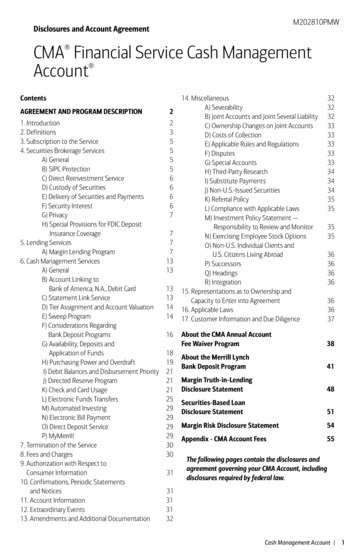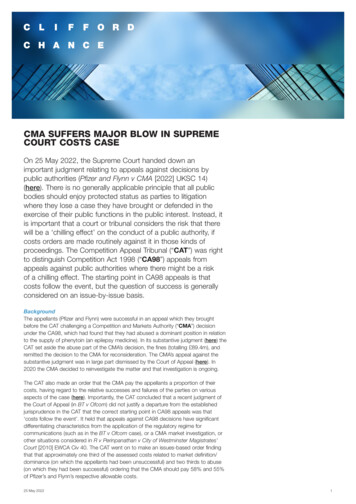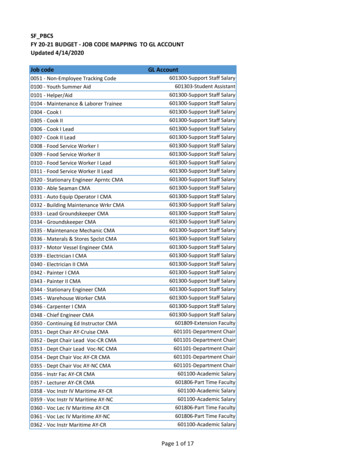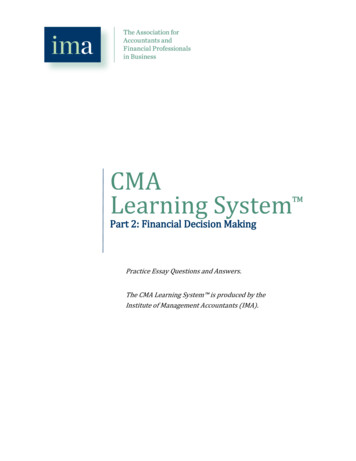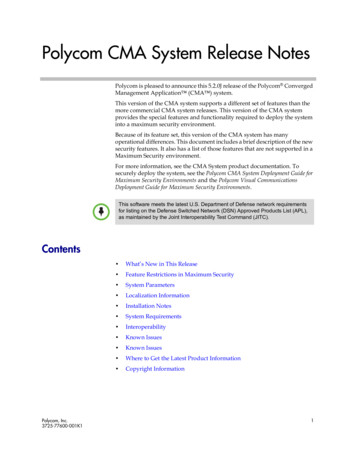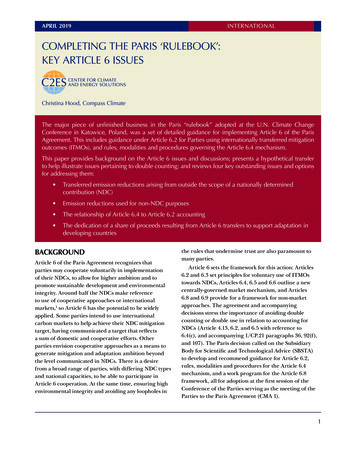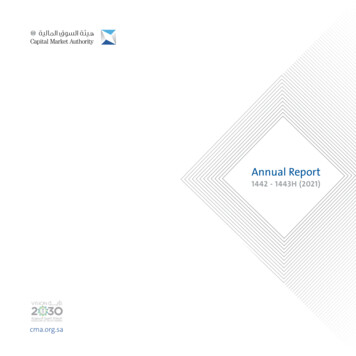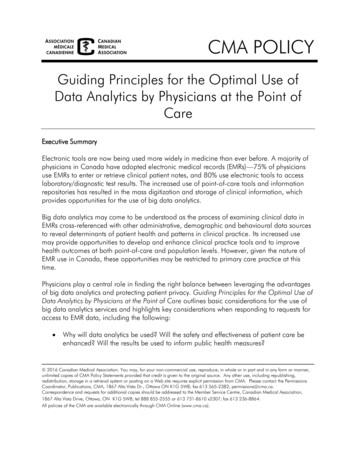
Transcription
CMA POLICYGuiding Principles for the Optimal Use ofData Analytics by Physicians at the Point ofCareExecutive SummaryElectronic tools are now being used more widely in medicine than ever before. A majority ofphysicians in Canada have adopted electronic medical records (EMRs)—75% of physiciansuse EMRs to enter or retrieve clinical patient notes, and 80% use electronic tools to accesslaboratory/diagnostic test results. The increased use of point-of-care tools and informationrepositories has resulted in the mass digitization and storage of clinical information, whichprovides opportunities for the use of big data analytics.Big data analytics may come to be understood as the process of examining clinical data inEMRs cross-referenced with other administrative, demographic and behavioural data sourcesto reveal determinants of patient health and patterns in clinical practice. Its increased usemay provide opportunities to develop and enhance clinical practice tools and to improvehealth outcomes at both point-of-care and population levels. However, given the nature ofEMR use in Canada, these opportunities may be restricted to primary care practice at thistime.Physicians play a central role in finding the right balance between leveraging the advantagesof big data analytics and protecting patient privacy. Guiding Principles for the Optimal Use ofData Analytics by Physicians at the Point of Care outlines basic considerations for the use ofbig data analytics services and highlights key considerations when responding to requests foraccess to EMR data, including the following: Why will data analytics be used? Will the safety and effectiveness of patient care beenhanced? Will the results be used to inform public health measures? 2016 Canadian Medical Association. You may, for your non-commercial use, reproduce, in whole or in part and in any form or manner,unlimited copies of CMA Policy Statements provided that credit is given to the original source. Any other use, including republishing,redistribution, storage in a retrieval system or posting on a Web site requires explicit permission from CMA. Please contact the PermissionsCoordinator, Publications, CMA, 1867 Alta Vista Dr., Ottawa ON K1G 5W8; fax 613 565-2382; permissions@cma.ca.Correspondence and requests for additional copies should be addressed to the Member Service Centre, Canadian Medical Association,1867 Alta Vista Drive, Ottawa, ON K1G 5W8; tel 888 855-2555 or 613 731-8610 x2307; fax 613 236-8864.All policies of the CMA are available electronically through CMA Online (www.cma.ca).
What are the responsibilities of physicians to respect and protect patient and physicianinformation, provide appropriate information during consent conversations, andreview data sharing agreements and consult with EMR vendors to understand howdata will be used?As physicians will encounter big data analytics in a number of ways, this document alsooutlines the characteristics one should be looking for when assessing the safety andeffectiveness of big data analytics services: protection of privacyclear and detailed data sharing agreementphysician-owned and -led data collaborativesendorsement by a professional or recognized association, medical society or healthcare organizationscope of services and functionality/appropriateness of dataWhile this guidance is not a standalone document—it should be used as a supplementalreference to provincial privacy legislation—it is hoped that it can aid physicians to identifysuitable big data analytics services and derive benefits from them.IntroductionThis document outlines basic considerations for the use of big data analytics services at thepoint of care or for research approved by a research ethics board. This includesconsiderations when responding to requests for access to data in electronic medical records(EMRs).These guiding principles build on the policies of the Canadian Medical Association (CMA) onData Sharing Agreements: Principles for Electronic Medical Records/Electronic HealthRecords,1 Principles Concerning Physician Information 2 and Principles for the Protection ofPatients’ Personal Health Information,3 the 2011 clinical vignettes Disclosing Personal HealthInformation to Third Parties4 and Need to Know and Circle of Care,5 and the CanadianMedical Protective Association’s The Impact of Big Data on Healthcare and MedicalPractice.6These guiding principles are for information and reference only and should not be construedas legal or financial advice, nor is this document a substitute for legal or other professionaladvice. Physicians must always comply with all legislation that applies to big data analytics,including privacy legislation. Big data analytics in the clinical context involves the collection,use and potential disclosure of patient and physician information, both of which could beconsidered sensitive personal information under privacy legislation.Big data analytics has the potential to improve health outcomes, both at the point of careand at a population level. Doctors have a key role to play in finding the right balance2
between leveraging the advantages of big data (enhanced care, service delivery and resourcemanagement) and protecting patient privacy.7BackgroundA majority of physicians in Canada have adopted EMRs in their practice. The percentage ofphysicians using EMRs to enter or retrieve clinical patient notes increased from 26% in 2007to 75% in 2014. Eighty percent of physicians used electronic tools to accesslaboratory/diagnostic test results in 2014, up from 38% in 2010.8 The increasingly broadcollection of information by physicians at the point of care, combined with the growth ofinformation repositories developed by various governmental and intergovernmental bodies,has resulted in the mass digitization and storage of clinical information.Big data is the term for data sets so large and complex that it is difficult to process them usingtraditional relational database management systems, desktop statistics and visualizationsoftware. What is considered “big” depends on the infrastructure and capabilities of theorganization managing the data.9Analytics is the discovery and communication of meaningful patterns in data. Analytics relieson the simultaneous application of statistics, computer programming and operationsresearch. Analytics often favours data visualization to communicate insight, and insights fromdata are used to guide decision-making.10For physicians, big data analytics may come to be understood as the process of examiningthe clinical data in EMRs cross-referenced with other administrative, demographic andbehavioural data sources to reveal determinants of patient health and patterns in clinicalpractice. This information can be used to assist clinical decision-making or for researchapproved by a research ethics board.There are four types of big data analytics physicians may encounter in the provision of patientcare. They are generally performed in the following sequence, in a continuous cycle11,12,13,14:1. Population health analytics: Health trends are identified in the aggregate within acommunity, a region or a national population. The data can be derived frombiomedical and/or administrative data.2. Risk-based cost analysis: Populations are segmented into groups according to thelevel of risk to the patient’s health and/or cost to the health system.3. Care management: Clinicians are enabled to manage patient care according todefined care pathways and clinical protocols informed by population health analyticsand risk-based cost analysis. Care management includes the following:3
o Clinical decision support: Outcomes are predicted and/or alternativetreatments are recommended to clinicians and patients at the point of care.o Personalized/precision care: Personalized data sets, such as genomic DNAsequences for at-risk patients, are leveraged to highlight best practicetreatments for patients and practitioners. These solutions may offer earlydetection and diagnosis before a patient develops disease symptoms.o Clinical operations: Workflow management is performed, such as wait-timesmanagement, mining historical and unstructured data for patterns to predictevents that may affect care.o Continuing education and professional development: Longitudinalperformance data are combined across institutions, classes, cohorts orprograms with correlating patient outcomes to assess models of educationand/or develop new programs.4. Performance analytics: Metrics for quality and efficiency of patient care are crossreferenced with clinical decision-making and performance data to assess clinicalperformance.This cycle is also sometimes understood as a component of “meaningful” or “enhanced” useof EMRs.How might physicians encounter big data analytics?Many EMRs run analytics both visibly (e.g., as a function that can be activated at appropriatejunctures in the care pathway) and invisibly (e.g., as tools that run seamlessly in thebackground of an EMR). Physicians may or may not be aware when data are being collected,analyzed, tailored or presented by big data analytics services. However, many jurisdictionsare strengthening their laws and standards, and best practices are gradually emerging.15Physicians may have entered into a data sharing agreement with their EMR vendor when theyprocured an EMR for their practice. Such agreements may include provisions to share deidentified (i.e., anonymized) and/or aggregate data with the EMR vendor for specified orunspecified purposes.Physicians may also receive requests from third parties to share their EMR data. Theserequests may come from various sources: provincial governmentsintergovernmental agenciesnational and provincial associations, including medical associationsnon-profit organizationsindependent researchersEMR vendors, service providers and other private corporations4
National Physician Survey results indicate that in 2014, 10% of physicians had shared datafrom their EMRs for the purposes of research, 10% for chronic disease surveillance and 8%for care improvement. Family physicians were more likely than other specialists to share withpublic health agencies (22% v. 11%) and electronic record vendors (13% v. 2%). Specialistswere more likely than family physicians to share with researchers (59% v. 37%), hospitaldepartments (47% v. 20%) and university departments (28% v. 15%).There is significant variability across the provinces with regard to what proportion ofphysicians are sharing information from their EMRs, which is affected by the presence ofresearch initiatives, research objectives defined by the approval of a research ethics board,the adoption rates of EMRs among physicians in the province and the functionality of thoseEMRs.16For example, there are family practitioners across Canada who provide data to the CanadianPrimary Care Sentinel Surveillance Network (CPCSSN). The CPCSSN is a multi-disease EMRsurveillance and research system that allows family physicians, epidemiologists andresearchers to understand and manage chronic care conditions for patients. Healthinformation is collected from EMRs in the offices of participating family physicians, specificallyinformation about Canadians suffering from chronic and mental health conditions and threeneurologic conditions, including Alzheimer’s and related dementias.17In another example, the Canadian Partnership Against Cancer’s Surgical Synoptic ReportingInitiative captures standardized information about surgery at the point of care and transmitsthe surgical report to other health care personnel. Surgeons can use the capturedinformation, which gives them the ability to assess adherence to the clinical evidence andsafety procedures embedded in the reporting templates, to track their own practices andthose of their community.18 The concept of synoptic reporting—whereby a physician providesanonymized data about their practice in return for an aggregate report summarizing thepractice of others —can be expanded to any area in which an appropriate number ofphysicians are willing to participate.Guiding principles for the use of big data analyticsThese guiding principles are designed to give physicians a starting point as they consider theuse of big data analytics in their practices: The objective of using big data analytics must be to enhance the safety and/oreffectiveness of patient care or for the purpose of health promotion.Should a physician use big data analytics, it is the responsibility of the physician to doso in a way that adheres to their legislative, regulatory and/or professionalobligations.Physicians are responsible for the privacy of their individual patients. Physicians maywish to refer to the CMA’s policy on Principles for the Protection of Patients’ PersonalHealth Information.195
Physicians are responsible for respecting and protecting the privacy of otherphysicians’ information. Physicians may wish to refer to the CMA’s policy on PrinciplesConcerning Physician Information.20When physicians enter into and document a broad consent discussion with theirpatient, which can include the electronic management of health information, thisagreement should convey information to cover the elements common to big dataanalytics services.Physicians may also wish to consider the potential for big data analytics to informpublic health measures and enhance health system efficiency and take this intoaccount when responding to requests for access to data in an EMR.Many EMR vendors provide cloud-based storage to their clients, so informationentered into an EMR may be available to the EMR vendor in a de-identified and/oraggregate state. Physicians should carefully read their data sharing agreement withtheir EMR vendor to understand how and why the data that is entered into an EMR isused, and/or they should refer to the CMA’s policy on the matter, Data SharingAgreements: Principles for Electronic Medical Records/Electronic Health Records. 21Given the dynamic nature of this emerging tool, physicians are encouraged to shareinformation about their experiences with big data analytics and its applications withcolleagues.Characteristics of safe and effective big data analytics services1. Protection of privacyPrivacy and security concerns present a challenge in linking big data in EMRs. As data arelinked, it becomes increasingly difficult to de-identify individual patients.22As care is increasingly provided in interconnected, digital environments, physicians are havingto take on the role of data stewardship. To that end, physicians may wish to employconservative risk assessment practices—“should we” as opposed to “can we” when linkingdata sources—and obtain express patient consent, employing a “permission-based”approach to the collection and stewardship of data.2. A clear and detailed data sharing agreementPhysicians entering into a contract with an EMR vendor or other third party for provision ofservices should understand how and when they are contributing to the collection of data forthe purposes of big data analytics services. There are template data sharing agreementsavailable, which include the basic components of safe and effective data sharing, such as themodel provided by the Information and Privacy Commissioner of Ontario.23Data sharing agreements may include general use and project-specific use, both of whichphysicians should assess before entering into the agreement. When EMR access is beingprovided to a ministry of health and/or regional health authority, the data sharing agreement6
should distinguish between access to administrative data and access to clinical data.Physicians may wish to refer to the CMA’s policy on Data Sharing Agreements: Principles forElectronic Medical Records/Electronic Health Records.243. Physician-owned and -led data collaborativesIn some provinces there may exist opportunities to share clinical data in physician-owned and-led networks to reflect on and improve patient care. One example is the Physicians DataCollaborative in British Columbia, a not-for-profit organization open to divisions of familypractice.25 Collaboratives such as this one are governed by physicians and driven by a desireto protect the privacy and safety of patients while producing meaningful results for physiciansin daily practice.Participation in physician-owned data collaboratives may ensure that patient data continue tobe managed by physicians, which may lead to an appropriate prioritization of physicians’obligations to balance patient-centred care and patient privacy.4. Endorsement by a professional or other recognized association or medical society orhealth care organizationWhen considering use of big data analytics services, it is best to select services created orendorsed by a professional or other recognized association or medical society. Some healthcare organizations, such as hospitals, may also develop or endorse services for use in theirclinical environments. Without such endorsement, physicians are advised to proceed withadditional caution.5. Scope of services and functionality/appropriateness of dataPhysicians may wish to seek out information from EMR vendors and service providers abouthow big data analytics services complement the process of diagnosis and about the range ofdata sources from which these services draw. While big data analytics promises insight intopopulation health and practice trends, if it is not drawing from an appropriate level of crossreferenced sources it may present a skewed picture of both.26 Ultimately, the physician mustdecide if the sources are appropriately diverse.Physicians should expect EMR vendors and service providers to make clear how and why theydraw the information they do in the provision of analytics services. Ideally, analytics servicesshould integrate population health analytics, risk-based cost analysis, care managementservices (such as point-of-care decision support tools) and performance analytics.Physicians should expect EMR vendors to allocate sufficient health informatics resources toinformation management, technical infrastructure, data protection and response to breachesin privacy, and data extraction and analysis.27,28Physicians may also wish to consider the appropriateness of data analytics services in the7
context of their practices. Not all data will be useful for some medical specialties, such asthose treating conditions that are relatively rare in the overall population. The potential fornew or enhanced clinical practice tools informed by big data analytics may be restricted toprimary care practice at this time.29Finally, predictive analytics often make treatment recommendations that are designed toimprove the health outcomes in a population, and these recommendations may conflict withphysicians’ ethical obligations to act in the best interests of individual patients and respectpatients’ autonomous decision-making).30References1Canadian Medical Association. Data sharing agreements: principles for electronic medical records/electronichealth records [CMA policy]. Ottawa: The Association; 2009. Available: .pdf2Canadian Medical Association. Principles concerning physician information [CMA policy]. CMAJ 2002167(4):393-4. Available: 9.pdf3Canadian Medical Association. Principles for the protection of patients’ personal health information [CMApolicy]. Ottawa: The Association; 2010. Available: 3.pdf4Canadian Medical Association. Disclosing personal health information to third parties. Ottawa: TheAssociation; 2011. Available: cy/CMA Disclosure third parties-e.pdf5Canadian Medical Association. Need to know and circle of care. Ottawa: The Association; 2011. t/en/advocacy/CMA Need to know circle care-e.pdf6Canadian Medical Protective Association. The impact of big data on healthcare and medical practice. Ottawa:The Association; no date. Available: 2750/com 14 big data design-e.pdf7Kayyali B, Knott D, Van Kuiken S. The ‘big data’ revolution in US health care: accelerating value andinnovation. New York: McKinsey & Company; 2013. p. 1.8College of Family Physicians of Canada, Canadian Medical Association, Royal College of Physicians andSurgeons of Canada. National physician survey, 2014. National results by FP/GP or other specialist, sex, ageand all physicians. Q7. Ottawa: The Colleges and Association; 2014. mous. Data, data everywhere. The Economist 2010 Feb 27. us. Data, data everywhere. The Economist 2010 Feb 27. Available:www.economist.com/node/1555744311Canada Health Infoway. Big data analytics in health. Toronto: Canada Health Infoway; 2013. rces/technical-documents/emergingtechnology/doc aper-full-report (accessed 2014 May 16).12Ellaway RH, Pusic MV, Galbraith RM, Cameron T. 2014 Developing the role of big data and analytics inhealth professional education. Med Teach 2014;36(3):216–222.13Marino DJ. Using business intelligence to reduce the cost of care. Healthc Financ Manage 2014;68(3):42–44,46.14Porter ME, Lee TH. The strategy that will fix health care. Harv Bus Rev 2013;91(10):50–70.15Baggaley C. Data protection in a world of big data: Canadian Medical Protective Association informationsession [presentation]. 2014 Aug 20. Available: 2750/com 2014 carmen baggaley-e.pdf16College of Family Physicians of Canada, Canadian Medical Association, Royal College of Physicians andSurgeons of Canada. National physician survey, 2014. National results by FP/GP or other specialist, sex, age8
and all physicians. Q10. Ottawa: The Colleges and Association; 2014. adian Primary Care Sentinel Surveillance Network. Available: http://cpcssn.ca/ (accessed 2014 Nov 15).18Canadian Partnership Against Cancer. Sustaining action toward a shared vision: 2012-2017 strategic plan.Toronto: The Partnership; no date. Available: Vision accessible.pdf19Canadian Medical Association. Principles for the protection of patients’ personal health information [CMApolicy]. Ottawa: The Association; 2011. Available: 3.pdf20Canadian Medical Association. Principles for the protection of patients’ personal health information [CMApolicy]. Ottawa: The Association; 2011. Available: 3.pdf21Canadian Medical Association. Data sharing agreements: principles for electronic medical records/electronichealth records [CMA policy]. Ottawa: The Association; 2009. Available: .pdf22Weber G, Mandl KD, Kohane IS. Finding the missing link for big biomedical data. JAMA2014;311(24):2479–2480. doi:10.1001/jama.2014.4228.23Information and Privacy Commissioner of Ontario. Model data sharing agreement. Toronto: TheCommissioner; 1995. Available: Canadian Medical Association. Data sharing agreements: principles for electronic medical records/electronichealth records [CMA policy]. Ottawa: The Association; 2009. Available: .pdf25Physicians Data Collaborative. Overview. Available: www.divisionsbc.ca/datacollaborative/home26Cohen IG, Amarasingham R, Shah A, Xie B, Lo B. The legal and ethical concerns that arise from usingcomplex predictive analytics in health care. Health Aff 2014;33(7):1139–1147.27Rhoads J, Ferrara L. Transforming healthcare through better use of data. Electron Healthc 2012;11(1):e27.28Canadian Medical Protective Association. The impact of big data and healthcare and medical practice.Ottawa: The Association; no date. Available: 2750/com 14 big data design-e.pdf29Genta RM, Sonnenberg A. Big data in gastroenterology research. Nat Rev Gastroenterol Hepatol2014;11(6):386–390.30Cohen IG, Amarasingham R, Shah A, Xie B, Lo B. The legal and ethical concerns that arise from usingcomplex predictive analytics in health care. Health Aff 2014;33(7):1139–1147.9
Guiding principles for the use of big data analytics These guiding principles are designed to give physicians a starting point as they consider the use of big data analytics in their practices: The objective of using big data analytics must be to enhance the safety and/or effectiveness of patient care or for the purpose of health promotion.

